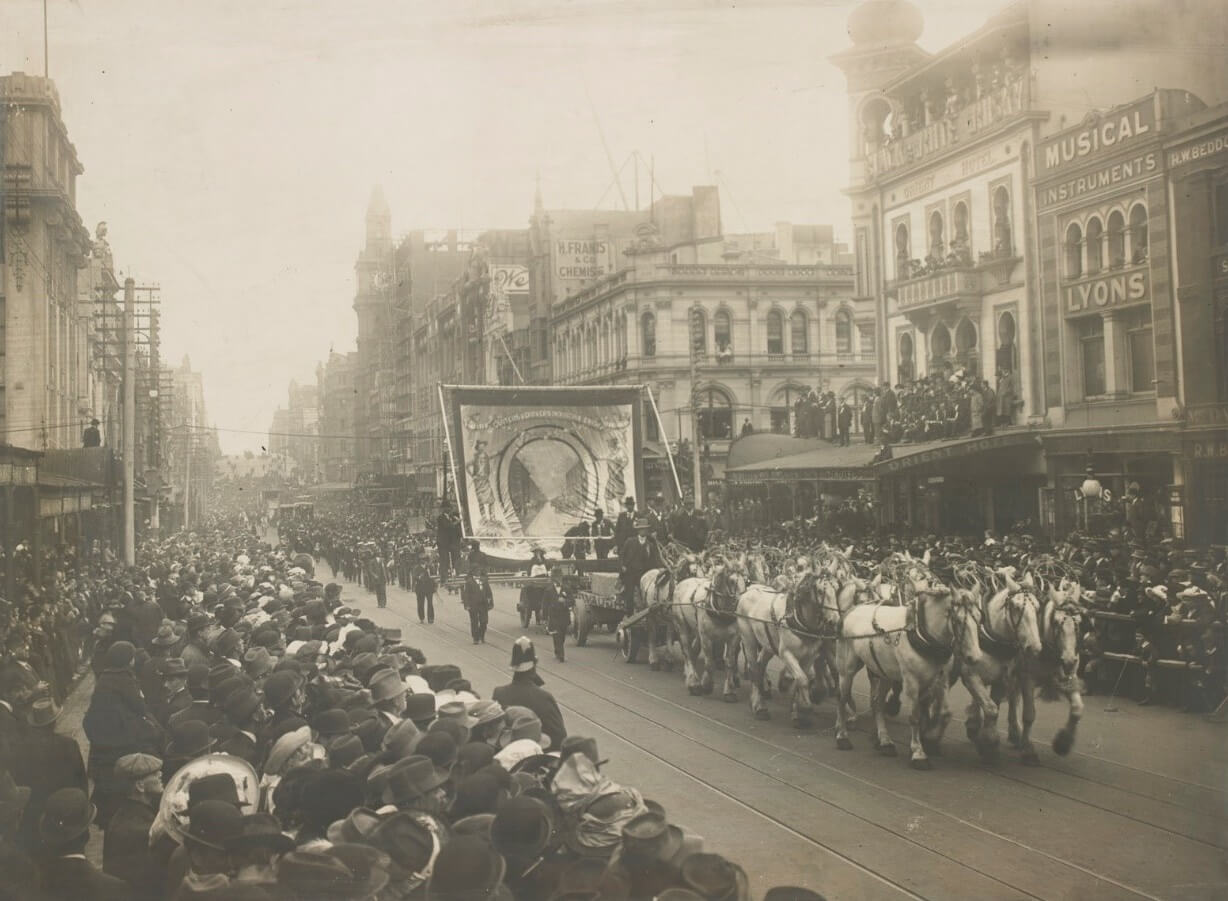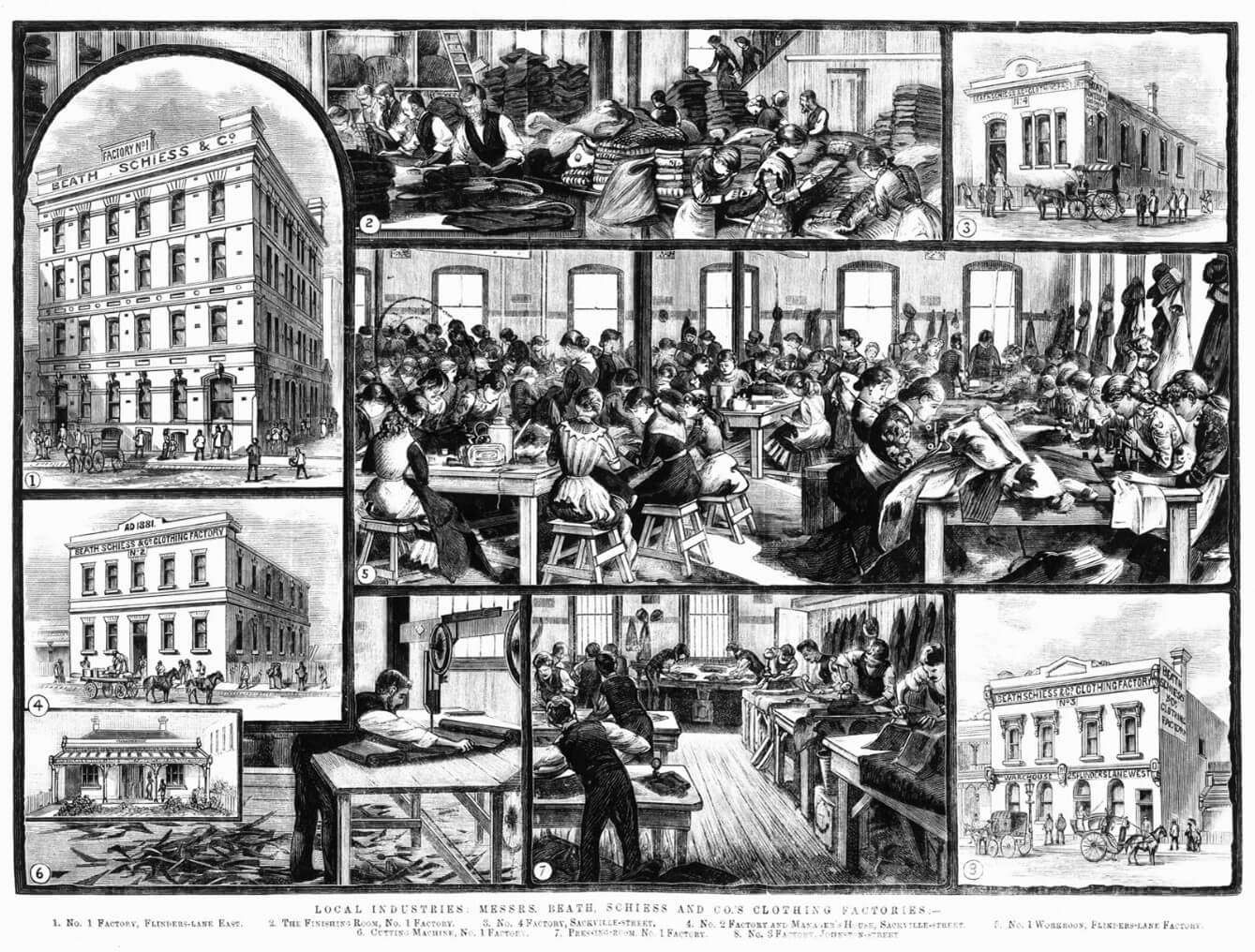McKay was not the only employer to put profit before the welfare of his workers. Conditions in many nineteenth century factories were poor, with long hours, few amenities for workers and minimal safety standards. Most workers were paid not by the hour, but by the ‘piece’ – or finished article. The first attempts to improve hours and conditions were made in the 1840s when several trade associations of skilled workers were formed. They included the Typographical Society and other associations linked to the building trade. In the buoyant labour conditions of gold rush Melbourne, some were able to negotiate shorter working hours. The first to win an eight-hour day were the stonemasons. In 1856 stonemasons engaged on major projects in Melbourne, including the University of Melbourne, downed tools and marched to the city, demanding an eight-hour working day. They were successful: their hours were reduced from 10 hours per day to eight, with no reduction in pay. Other trades followed and the Eight Hours Movement was soon a strong force, with its slogan ‘Eight hours’ work, eight hours’ rest, eight hours’ recreation’. A march of association members who had achieved an eight-hour day became a popular annual event in Melbourne, with unions competing to carry elaborately-worked banners in procession.
But the success of skilled tradesmen did not flow on to other workers. The trade associations were exclusive societies intent on maintaining the privileges of skilled tradesmen and their fees were set accordingly. It was not until later in the century that unions like the Bootmakers Union formed to represent semi-skilled workers and those in manufacturing. With low annual fees, these unions soon grew to represent a large membership base. Separate unions were formed initially to represent women workers who were often excluded from the ‘male’ unions. Especially successful female unions were the Female Confectioners’ Union and the Tailoresses’ Association of Melbourne. The tailoresses organised a successful strike against reduced piece rates in Melbourne in 1882-3, with some sympathetic coverage in the Age.
On Tuesday 5 December 1882, having just been informed that their piece rates were to be reduced even further, 300 or so women employed at Messrs. Beath, Schiess and Co. put down their work and walked out into Flinders Lane […] Before the proposed reduction, a trouser hand such as she [Ellen Creswell] could make 25 shillings a week, but only if she took home extra pairs at night. On the new rates, she would have struggled to make 20 shillings. Another employee at Beath and Schiess told the Age a similar story: before she had been able to earn no more than 24 shillings a week, working 14 hours a day. The proposed reduction would bring her ‘down to eighteen shillings or one pound at the most’, and this for ‘working from half-past eight in the morning to half past five in the afternoon with half an hour’s interval for lunch and three to four hours work in the evenings at home’. Another woman, employed as a coat hand, anonymously told the Age how six weeks before, the firm had tried to reduce the price for a coat from four shillings and eight pence to 4 shillings and tuppence. In this instance the workers had ‘refused to accept it’, and they had only taken threepence off instead. ‘We submitted to this’, she admitted, ‘but [when] they said that they would take off another threepence, then we struck’. (cited in Thornton)
From the 1870s conditions of work in factories also began to improve as a succession of Factory Acts addressed working hours and issues such as overcrowding of workrooms.
Local industries: Messers Beath, Schiess and Co’s Clothing factories, 1882
Reproduced courtesy State Library Victoria
This engraving was published in the Illustrated Australian News, 13 May 1882. The individual mages were described as follows:
1. No. 1 factory, Flinders-Lane east. -- 2. The finishing room, No. 1 factory. -- 3. No. 4 factory, Sackville-Street. -- 4. No. 2 factory and manager's house, Sackville-Street. -- 5. No. 1 workroom, Flinders-Lane factory. -- 6. Cutting machine, No. 1 factory. -- 7. Pressing-room, No. 1 factory. -- 8. No. 3 factory, Johnson-Street.
The gendered division of labour that operated in clothing factories is visible in these images, with the women and girls sewing around tables and the men operating the cutting machine and pressing the finished products, using heavy tailors’ irons. This workroom is certainly crowded, as a royal commission of 1882-4 noted in its report. Women workers from Beath, Schiess & Co went out on strike in late 1882-3 when piece rates were further reduced in the factory.


